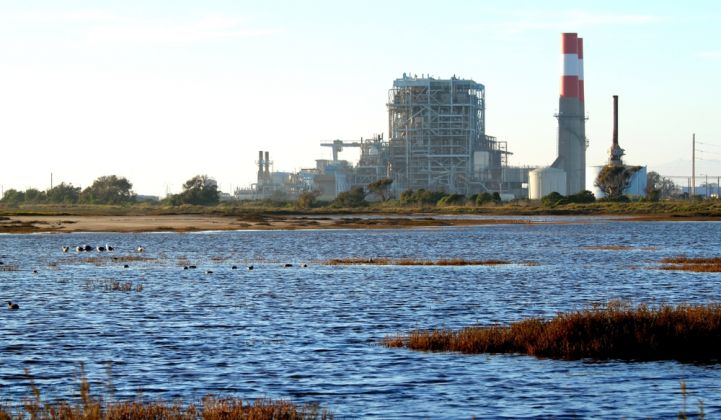There’s one way to settle California’s energy storage versus gas peaker argument once and for all: a new procurement round.
The California Independent System Operator suggested this course of action in a filing to the California Energy Commission (CEC) last week, which addressed concerns about its study comparing storage alternatives to NRG's proposed Puente gas plant for serving local reliability in Oxnard.
That plant, first proposed years ago to prepare for the retirement of gas plants due to new water regulations, has come under fire for cementing new fossil fuel infrastructure at a time when the state is moving away from it. The process is building toward a CEC ruling on whether to grant it certification to move forward.
A CAISO study released in August showed that energy storage and other distributed assets (“preferred resources," in California energy jargon) could serve the reliability needs of the local system, but at 2.7 times the projected cost of the new gas plant. A GTM investigation found that the study’s analysis used outdated storage cost projections, meaning that real storage pricing could be closer to the cost of Puente.
In its response to criticism of the study, CAISO reiterated the core finding: “The Moorpark Study demonstrates that preferred resource alternatives are technologically feasible to meet local capacity requirements in the Moorpark sub-area.”
Then the grid operator ups the ante.
“The economic feasibility of the preferred resource portfolios can only be established through a new RFO,” the filing states.
The scope of CAISO's study was high-level and drew on publicly available price data. The new filing acknowledges that battery costs have been trending downward since its source data (a Navigant analysis from 2014) was compiled.
There’s a mechanism to figure out a more comprehensive and up-to-date pricing analysis for energy storage to play this role: conduct a new request for offers and let the different assets battle it out for cost-effectiveness. NRG might point out that its proposal already went through a procurement process, but it did so before the preferred resources matured enough to be able to compete on a technical or cost-effective basis.
Should the state launch a new RFO, CAISO cautions against judging the options based on a narrow understanding of cost-competitiveness.
“An economically feasible option need not be the least expensive option, especially given the environmental and performance issues that are unique to each portfolio,” the document says.
Those words hold a tantalizing promise for the environmentalists, environmental justice advocates and clean energy professionals pushing for an alternative to a new gas peaker.
It’s hardly surprising for a gas plant to beat energy storage on a simple upfront cost comparison. That accounting leaves out externalities such as greenhouse gas emissions, local air pollution and quality of life in the neighborhood. Storage in particular stands to benefit from analysis that includes revenue streams beyond local reliability: When the asset isn’t needed for that purpose, it theoretically can generate revenue through frequency regulation, capacity and other services.
A strict cost comparison works to Puente and NRG’s benefit. A more holistic accounting of “environmental and performance issues” gives distributed storage and solar a better shot.
If regulators decide to do an RFO, they had better do it fast, CAISO warns.
The Puente plant is intended to replace generators that will come offline by the end of 2020 due to the state’s regulation on “once-through cooling” plants, which use ocean water for chilling operations. The replacement needs to be in place by the summer 2021 peak season.
“With just over three years before the once-through-cooling compliance deadline, there appears to be an opportunity to conduct an expedited RFO and operationalize preferred resources prior to the summer 2021 timeframe,” the filing notes.
That’s significant. The independent body tasked with keeping the grid running just publicly asserted that it’s feasible to run an expedited RFO for gas plant alternatives and get those assets up and running in time to avert a local energy crisis.
"I have to imagine CAISO carries more weight than almost anyone, because CAISO operates the grid and maintains reliability," said VP of GTM Research Shayle Kann, who has been following the Puente process. "Say what you need, let people bid on it -- if CAISO thinks there's enough time to run that, then why not?"
If the CEC rejects Puente, the California Public Utilities Commission could request the new RFO. It's not immediately clear whether the CEC can ask for an RFO before voting on the Puente approval.
In related news, last week the CPUC unanimously rejected a plan to refurbish the Ellwood Peaker Plant, which is located in the same strained grid region as the proposed Puente site. The refurbishment would have allowed the gas plant to operate for another 30 years.
The commissioners instead want to explore a more diverse array of solutions that are in line with the state's goals of moving away from fossil fuels.
"This is a real action that will result in renewables playing a role that would normally have gone to natural gas," said Craig Lewis, executive director of the Clean Coalition, which advocated for clean distributed solutions in both cases. "If we can bring solar and storage together to obviate the need for Ellwood, we can do the same thing for Puente."
The CPUC's reasoning on the Ellwood decision resonates, at least superficially, with the decision facing the CEC commissioners on Puente. We're still a few weeks out from seeing how CAISO's or the CPUC's logic filters into the energy commissioners' decision-making process.
--
Join GTM for a deep dive into the budding domestic energy storage market at the U.S. Energy Storage Summit 2017. Utilities, financiers, regulators, technology innovators, and storage practitioners will all come together for two full days of data-intensive presentations, analyst-led panel sessions with industry leaders, and extensive, high-level networking. Learn more here.



